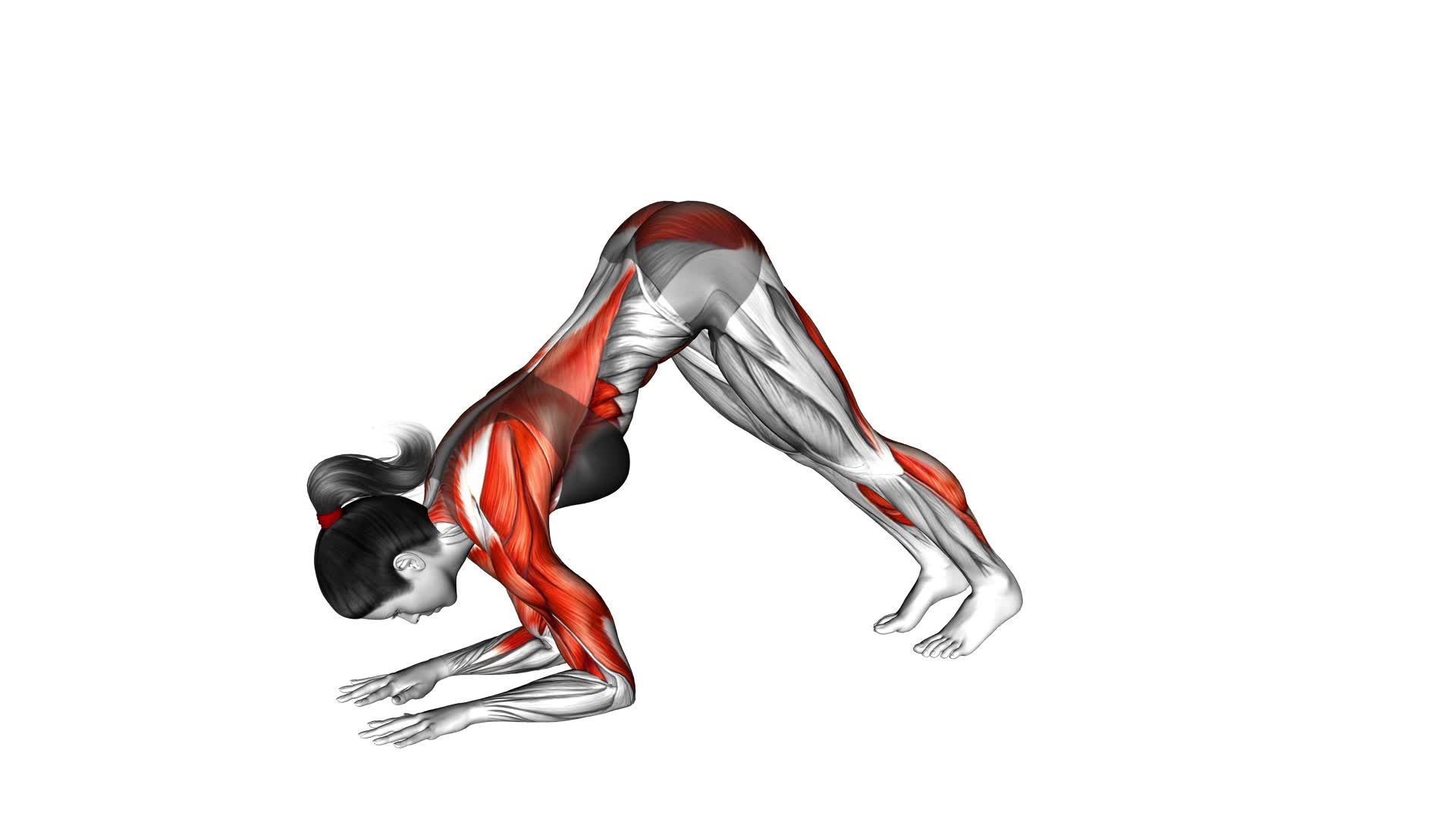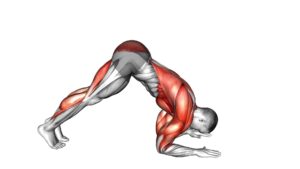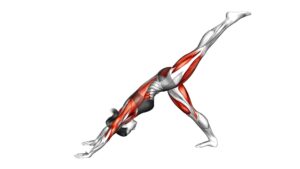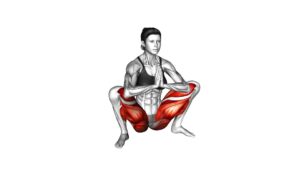Dolphin Pose (female) – Video Exercise Guide & Tips

Are you looking for a new yoga pose that targets your core and upper body? Look no further than Dolphin Pose!
Watch This Exercise Video
In this video exercise guide, we'll show you how to properly align your body and provide modifications and variations to suit your level. Whether you're a beginner or more experienced, we've got tips to help you improve your Dolphin Pose.
Get ready to dive into this invigorating yoga pose and feel the benefits in no time!
Key Takeaways
- Dolphin Pose strengthens core muscles
- Dolphin Pose improves flexibility in hamstrings, calves, and shoulders
- Dolphin Pose enhances focus and concentration
- Dolphin Pose targets shoulders, arms, and core muscles
Benefits of Dolphin Pose
Discover the numerous physical and mental benefits of practicing Dolphin Pose, a powerful yoga posture that can strengthen your core, improve flexibility, and enhance focus.
Dolphin Pose, also known as Ardha Pincha Mayurasana, is an intermediate level pose that targets the shoulders, arms, and core muscles. By regularly practicing this pose, you can experience a wide range of benefits that contribute to your overall well-being.
One of the key benefits of Dolphin Pose is its ability to strengthen your core. As you engage your abdominal muscles to hold the pose, you build strength and stability in your midsection. This not only helps to improve your posture but also enhances your overall body strength.
In addition to core strength, Dolphin Pose also improves flexibility. This pose stretches the hamstrings, calves, and shoulders, increasing your range of motion in these areas. By regularly practicing Dolphin Pose, you can gradually increase your flexibility and prevent muscle tightness and imbalances.
Furthermore, Dolphin Pose can enhance your focus and concentration. This pose requires mental concentration to maintain proper alignment and balance. By bringing your attention to the present moment and focusing on your breath, you can improve your ability to concentrate both on and off the mat.
Modifications and variations of Dolphin Pose allow individuals of different levels and abilities to experience its benefits. For beginners, using a wall for support can make the pose more accessible. Advanced practitioners can explore variations such as Dolphin Plank Pose or Dolphin Pose with leg lifts to further challenge their strength and stability.
Now that you understand the benefits of Dolphin Pose, let's move on to how to properly align your body in this powerful yoga posture.
How to Properly Align Your Body in Dolphin Pose
To properly align your body in Dolphin Pose, it's important to focus on three key points.
First, ensure that your shoulders and spine are aligned, with your shoulders directly over your elbows and your back straight.
Second, engage your core muscles by drawing your belly button towards your spine, which will help stabilize your body in the pose.
Finally, maintain a neutral head position, avoiding any strain or tension in your neck.
Shoulder and Spine Alignment
To properly align your body in Dolphin Pose, make sure that your shoulders and spine are in proper alignment. This will help you achieve the maximum benefits of the pose while minimizing the risk of injury. Here are some tips for achieving shoulder and spine alignment in Dolphin Pose:
- Engage your core: Activate your abdominal muscles to support your spine and maintain stability throughout the pose.
- Keep your shoulders relaxed: Avoid tensing your shoulders or hunching them up towards your ears. Instead, focus on keeping them relaxed and away from your neck.
- Lengthen your spine: Imagine a string pulling the crown of your head towards the ceiling, lengthening your spine and maintaining a straight line from your head to your tailbone.
- Avoid excessive arching: Be mindful of your lower back and avoid excessive arching. Keep your pelvis neutral to protect your spine.
Engaging Core Muscles
To properly engage your core muscles in Dolphin Pose and maintain proper alignment of your body, follow these tips.
Engaging your core muscles is essential for building strength and stability in this pose. Start by drawing your navel towards your spine, activating your deep abdominal muscles. This will create a strong foundation for the pose and protect your lower back.
Next, squeeze your glutes to engage your pelvic floor muscles, which will further support your core. As you lift your hips up, imagine pulling your belly button towards your spine, lengthening your entire torso.
Keep your core engaged throughout the pose to maintain stability and prevent any strain on your back. Remember, building core strength takes time, so be patient and consistent with your practice.
Proper Head Position
Aligning your head properly in Dolphin Pose is crucial for maintaining proper body alignment and maximizing the benefits of the pose. Here are some key points to keep in mind for head positioning and neck alignment:
- Keep your head in line with your spine, avoiding any excessive tilting or lifting.
- Gently lengthen the back of your neck while maintaining a relaxed and neutral position.
- Allow your gaze to naturally fall between your forearms, creating a soft focus point.
- Avoid straining your neck by keeping it relaxed and avoiding any tension.
By aligning your head correctly in Dolphin Pose, you can maintain proper body alignment and prevent any unnecessary strain on your neck and spine.
Now let's explore some modifications and variations for Dolphin Pose to further enhance your practice.
Modifications and Variations for Dolphin Pose
When practicing Dolphin Pose, there are several modifications and variations you can explore to suit your needs and level of flexibility.
You can choose to perform the pose with your arms extended or on your forearms, depending on what feels comfortable for you.
Additionally, you can use a wall for support or challenge yourself by practicing the pose without one.
Lastly, experimenting with different breathing techniques can enhance your experience and deepen your practice.
Arms or Forearms
If you want to modify or vary your Dolphin Pose, you can try different arm or forearm positions. By changing your arm placement, you can target different muscles and increase the challenge of the pose. Here are some variations to try:
- Forearms parallel: Start in Dolphin Pose with your forearms parallel to each other. This variation focuses on building shoulder and core strength.
- Forearms wide: Place your forearms wider than shoulder-width apart. This variation helps improve shoulder mobility and stability.
- Hands clasped: Instead of resting on your forearms, clasp your hands together. This variation intensifies the stretch in the shoulders and upper back.
- One arm extended: Extend one arm forward while maintaining the Dolphin Pose. This variation challenges your balance and engages the shoulder and arm muscles even more.
Experiment with these different arm and forearm positions to find the variation that works best for you and helps you strengthen your shoulders.
Wall or No Wall
To modify or vary your Dolphin Pose, you can choose to practice with or without a wall for additional support and modifications. Using a wall can be especially beneficial for beginners or those with limited upper body strength.
To practice with a wall, start by standing facing the wall with your feet hip-width apart. Place your forearms on the wall, shoulder-width apart, and walk your feet back until your body forms an inverted V shape. Press your forearms into the wall and engage your core to maintain stability. This modification allows you to focus on building strength in your shoulders and upper back while still gaining the benefits of Dolphin Pose.
For more advanced modifications, you can try practicing without a wall, which will challenge your balance and stability even more. Remember to always listen to your body and modify as needed.
Breathing Techniques?
To enhance your Dolphin Pose, explore different breathing techniques and their modifications and variations. Here are some options to consider:
- Ujjayi Breath: This deep, audible breath helps to generate heat in the body and focus the mind. In Dolphin Pose, try inhaling and exhaling through the nose, constricting the back of the throat to create a gentle sound.
- Three-Part Breath: This technique involves breathing into three areas of the body – the belly, ribs, and upper chest. In Dolphin Pose, inhale deeply into the belly, expand the ribs, and finally fill the upper chest. Exhale in reverse order, releasing the air from the upper chest, ribs, and finally the belly.
- Alternate Nostril Breath: This practice involves inhaling and exhaling through one nostril at a time. In Dolphin Pose, use the thumb to close the right nostril and inhale through the left. Then, close the left nostril with the ring finger, release the thumb, and exhale through the right nostril. Repeat on the other side.
- Extended Exhalation: This technique involves lengthening the exhale compared to the inhale. In Dolphin Pose, try inhaling for a count of three and exhaling for a count of six. This can help to activate the parasympathetic nervous system and promote relaxation.
Tips for Beginners to Improve Their Dolphin Pose
Improve your Dolphin Pose as a beginner with these helpful tips. To enhance your flexibility, it's important to warm up before attempting the pose. Start with a few rounds of Cat-Cow Pose to loosen up your spine and engage your core. Additionally, incorporate regular stretching exercises into your routine, focusing on your shoulders, hamstrings, and calves. This will gradually improve your flexibility over time.
To strengthen your upper body, practice Plank Pose regularly. This pose targets the core muscles, arms, and shoulders, which are key to maintaining a stable Dolphin Pose. Start with short holds and gradually increase the duration as you build strength. Incorporating exercises such as push-ups and forearm planks into your routine can also help strengthen the muscles needed for Dolphin Pose.
When performing the Dolphin Pose, ensure that your shoulders are directly over your elbows and your forearms are parallel to each other. This alignment will provide a strong foundation for the pose. Avoid sinking into your shoulders and keep your neck relaxed. Remember to engage your core and lengthen through your spine.
Common Mistakes to Avoid in Dolphin Pose
One common mistake to avoid in Dolphin Pose is improper alignment of the shoulders and elbows. When performing this pose, it's important to ensure that your shoulders and elbows are stacked directly above your wrists. This proper alignment helps to distribute the weight evenly and prevents unnecessary strain on your joints.
Here are some other common mistakes to watch out for:
- Allowing your head to hang between your arms: Instead, focus on keeping your head in line with your spine to maintain proper alignment.
- Arching your lower back: To avoid this, engage your core muscles and lengthen through your tailbone.
- Holding your breath: Remember to breathe deeply and continuously throughout the pose.
- Overexerting your neck muscles: If you feel tension in your neck, try modifying the pose by using a block or bolster to support your head.
Incorporating Dolphin Pose Into Your Yoga Routine
Start incorporating Dolphin Pose into your yoga routine for increased strength and flexibility. Dolphin Pose is a powerful yoga pose that targets the shoulders, core, and upper back, while also stretching the hamstrings and calves. It can be a great addition to your vinyasa flow practice, helping to build heat and improve mobility.
To incorporate Dolphin Pose into a vinyasa flow, begin in a high plank position. From there, lower your forearms to the mat, keeping them parallel to each other. Press your palms firmly into the mat, engaging your core and lengthening through your spine. Lift your hips up and back, coming into Dolphin Pose. Take a few breaths here, allowing your body to settle into the pose.
If you find it challenging to maintain proper alignment or want to deepen the stretch, you can use props to enhance Dolphin Pose. Place a block between your forearms to help maintain the correct distance and alignment. You can also use a strap around your upper arms to keep them parallel and engaged.
Incorporating Dolphin Pose into your yoga routine can bring numerous benefits, including increased upper body strength, improved shoulder flexibility, and a stronger core. So why not give it a try and experience the transformative effects of this powerful pose?
Frequently Asked Questions
Can Dolphin Pose Help With Relieving Back Pain?
Yes, dolphin pose can help relieve back pain. By practicing this pose, you can strengthen your core and stretch your spine, which can alleviate tension in your back muscles.
Dolphin pose benefits also include improved posture and increased flexibility. To maximize the benefits, try different variations of the pose, such as using props or modifying the position of your arms.
Incorporating dolphin pose into your regular yoga routine can be a valuable tool for managing and preventing back pain.
Is Dolphin Pose Safe for Pregnant Women?
Dolphin Pose is a popular yoga pose that offers several benefits.
When it comes to pregnant women, safety is a top priority. Before practicing any exercise during pregnancy, it's important to consult with your healthcare provider. They'll be able to guide you on what's safe and appropriate for your specific pregnancy.
Dolphin Pose may be modified or avoided altogether depending on your individual needs and stage of pregnancy.
Always prioritize the safety and well-being of you and your baby.
How Long Should I Hold Dolphin Pose for Maximum Benefits?
To get the maximum benefits from dolphin pose, it's important to hold it for an optimal amount of time. By holding the pose for 30 to 60 seconds, you can improve your core strength and stability.
Dolphin pose variations can also be beneficial, such as lifting one leg or extending your arms forward.
Remember to listen to your body and take breaks when needed.
With consistent practice, you'll see improvements in your core strength and overall fitness.
Can Dolphin Pose Help Improve Posture?
Dolphin pose can definitely help improve your posture. By stretching and strengthening the muscles in your shoulders, upper back, and core, this pose promotes proper alignment and encourages a more upright position.
It also helps to improve flexibility in your spine and hamstrings, which can further support good posture. Practicing dolphin pose regularly, along with other exercises that target posture, can contribute to a stronger and more balanced body.
What Are the Potential Emotional Benefits of Practicing Dolphin Pose?
Practicing Dolphin Pose can bring you potential emotional benefits. It can help with stress relief, allowing you to unwind and find inner calm. By regularly practicing this pose, you may also experience increased self-confidence.
Dolphin Pose helps to strengthen your core and improve your posture, which can boost your overall confidence and make you feel more empowered. So, give Dolphin Pose a try and experience these emotional benefits for yourself.
Conclusion
In conclusion, Dolphin Pose is a beneficial yoga pose that offers several advantages. It strengthens the upper body, stretches the hamstrings, and improves posture. By properly aligning your body and making modifications as needed, you can deepen the pose and avoid common mistakes.
For beginners, it is important to start slowly and gradually improve their Dolphin Pose. Regular practice and focusing on proper form are key to making progress. Over time, incorporating Dolphin Pose into your yoga routine can enhance your overall flexibility and strength.
So, if you're ready to experience the benefits of Dolphin Pose, grab your yoga mat and give it a try!

Author
Years ago, the spark of my life’s passion ignited in my mind the moment I stepped into the local gym for the first time. The inaugural bead of perspiration, the initial endeavor, the very first surge of endorphins, and a sense of pride that washed over me post-workout marked the beginning of my deep-seated interest in strength sports, fitness, and sports nutrition. This very curiosity blossomed rapidly into a profound fascination, propelling me to earn a Master’s degree in Physical Education from the Academy of Physical Education in Krakow, followed by a Sports Manager diploma from the Jagiellonian University. My journey of growth led me to gain more specialized qualifications, such as being a certified personal trainer with a focus on sports dietetics, a lifeguard, and an instructor for wellness and corrective gymnastics. Theoretical knowledge paired seamlessly with practical experience, reinforcing my belief that the transformation of individuals under my guidance was also a reflection of my personal growth. This belief holds true even today. Each day, I strive to push the boundaries and explore new realms. These realms gently elevate me to greater heights. The unique combination of passion for my field and the continuous quest for growth fuels my drive to break new ground.



